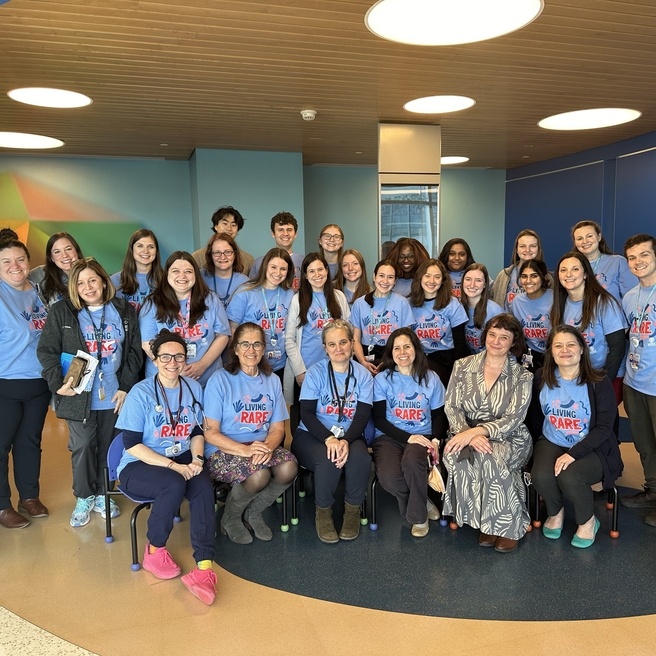What is metachromatic leukodystrophy?
Metachromatic leukodystrophy (MLD) is a rare genetic disorder that affects many parts of the body, including the brain, the nerves outside of the brain and spinal cord (peripheral nerves), and the gallbladder. It is a type of leukodystrophy, a group of conditions that affect the white matter of the brain. In MLD, fatty substances (called sulfatides) build up and damage the myelin sheath — the protective coating around nerve cells in the brain and spinal cord — which helps messages travel quickly between cells. Without healthy myelin, messages from the brain travel slowly or stop altogether, leading to serious nerve problems.
Causes of metachromatic leukodystrophy
Most people with MLD are born with a change in the ARSA gene. This gene makes a helpful protein that breaks down sulfatides. In people with MLD, the body doesn't make enough of this protein, so sulfatides build up and slowly damage the nerves.
For a small number of people with MLD, a change in a different gene, called PSAP, causes the same problem. Although the two genes are different, the symptoms and outcome are the same.
Signs and symptoms of metachromatic leukodystrophy
There are multiple forms of MLD, based on when symptoms appear: late infantile, early juvenile, late juvenile and adult.
In children, symptoms include:
- Slow development or delays in reaching milestones
- Trouble walking
- Unusual eye movements
- Problems with feeding
- Constipation
- Nerve damage
In adults, symptoms include:
- Changes in thinking, memory or learning
- Mental health or behavioral changes
Gallbladder disease can affect both children and adults with MLD.
Testing and diagnosis for metachromatic leukodystrophy
In addition to looking at physical symptoms, diagnosing MLD involves several tests:
- A brain MRI (magnetic resonance imaging) can show patterns in brain tissue that are typical of MLD.
- Blood and urine tests, called biochemical testing, check levels of arylsulfatases and the concentration of sulfatides.
- Genetic testing looks for changes in one of the genes linked to MLD. This test is done from a blood or saliva sample or a cheek swab. The results, along with other tests, can lead to a diagnosis of MLD.
- Neuropsychological testing evaluates how the condition is affecting a person’s thinking, memory, problem-solving and focus.
Together, results from these tests give a clear picture and help confirm the diagnosis.
Treatment for metachromatic leukodystrophy
There is no known cure for MLD, but some children may be eligible for treatments that can significantly change the progression of the disease. These include:
Stem cell transplant
A stem cell (bone marrow) transplant may stop or slow the progression of MLD. It works best if it is done early, before symptoms progress. This treatment requires a match from a bone marrow registry or a family member.
Gene therapy
Atidarsagene autotemcel (brand name: Lenmeldy™) is a one-time treatment for babies and young children with early signs of MLD. Doctors remove the child’s own stem cells, add the healthy ARSA gene, and return the cells to the child’s body (called ex vivo gene therapy). This treatment can delay or lessen MLD symptoms. It doesn’t require a bone marrow match because a child’s own cells are used.
Symptom management
There are also treatments to help to manage symptoms and keep children comfortable. Each child’s treatment is unique depending on their symptoms.
Children with MLD should be monitored for:
- Gallbladder disease
- Nerve damage (peripheral neuropathy) and damage to the brain’s white matter (central demyelination)
- Bone issues, such as scoliosis, dislocated joints and low bone density, which are linked to motor issues in MLD
- Feeding, growth and weight changes
- Changes in eye movement
- Thinking or mood changes
If any of these conditions are found, pediatric subspecialists can help treat them. Many children with MLD also benefit from physical, occupational and speech therapy to combat challenges caused by MLD.
Follow-up
Children with MLD need regular monitoring by neurologists, as well as ongoing therapy and coordinated care by other medical subspecialists as needed. At Children’s Hospital of Philadelphia (CHOP), families have access to advanced, multidisciplinary care, delivered by clinicians with deep expertise in leukodystrophies, all within a compassionate, family-centered environment.
Long-term outlook for children with metachromatic leukodystrophy
MLD is a progressive, life-limiting disease, with symptoms that worsen over time. However, innovative treatments, like gene therapy, can slow disease progression and improve quality of life. CHOP is one of the premiere institutions for leukodystrophy care and a designated Center of Excellence. Our ongoing research efforts aim to enhance outcomes for children with MLD and offer families hope for the future of leukodystrophy care.
Resources to help
Leukodystrophy Center Resources
We have created resources to help you find answers to your questions and feel confident with the care you are providing your child.
Reviewed on 07/25/2025
